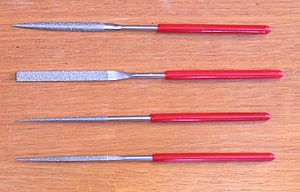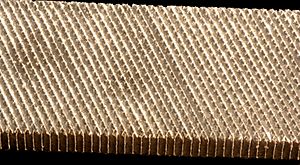File (tool) facts for kids

A file is a special tool that helps you shape different materials. It works by gently scraping away small bits of the material. Most files today are made from a strong steel bar. This bar has a very rough surface with many tiny teeth. When you rub the file against something, these teeth scrape off tiny pieces.
Files are used for many jobs. You can use them to make a surface smooth. This is helpful when two pieces need to fit together perfectly. Files can also remove sharp edges or shape a material into a new form. For example, nail files are used to shape your fingernails. A file is called "blunt" if it has the same width from one end to the other. If one end is narrower than the other, it is called "tapered."
Contents
What is a File Made Of?
Files are usually made from very strong steel. This steel is heated and then shaped. After shaping, the file is hardened. This makes the teeth on its surface very tough. These teeth are what do the work of scraping. The way these teeth are cut is called the "cut" of the file.
Different Kinds of File Cuts
Files have different types of cuts. These cuts change how the file works.
- Single-cut files: These files have rows of teeth that go in one direction. They are good for light work and for making surfaces smooth.
- Double-cut files: These files have two sets of teeth that cross each other. They remove material much faster. This makes them good for rough shaping.
- Rasp-cut files: These files have individual, sharp teeth that stick out. They are used for softer materials like wood or leather. They remove a lot of material quickly.
- Curved-tooth files: These files have teeth that are curved. They are often used on softer metals like aluminum.
Parts of a File
A file has a few main parts:
- Face: This is the main flat part of the file with the teeth. It's the part you use to scrape.
- Edge: The narrow sides of the file. Some edges have teeth, and some are smooth.
- Point or Tip: The end of the file opposite the handle.
- Tang: This is the narrow, pointed part of the file. It fits inside the handle.
- Handle: The part you hold. It's usually made of wood or plastic. It helps you grip the file safely.
How to Use a File Safely
Using a file correctly is important for safety and good results.
- Always use a file with a proper handle. A file without a handle can be dangerous. The tang can hurt your hand.
- Make sure the material you are filing is held firmly. You can use a vice to hold it.
- Push the file forward across the material. Don't press down too hard when pulling it back. This can dull the teeth.
- Keep the file clean. Use a special brush called a "file card" to remove metal bits from the teeth.
Types of Files
There are many different types of files. Each type is designed for specific jobs.
- Hand files: These are common files with parallel sides. They are used for general shaping.
- Flat files: These files are rectangular and are used for flat surfaces.
- Half-round files: These files have one flat side and one curved side. They are good for both flat and curved surfaces.
- Round files: These files are round and tapered. They are used to enlarge holes or shape curved openings.
- Square files: These files have four sides. They are used for square holes or corners.
- Triangular files: These files have three sides. They are good for sharpening saw teeth or cleaning corners.
- Needle files: These are very small files. They come in many shapes. They are used for delicate work, like jewelry making.
- Riffler files: These files have curved ends. They are used for reaching into awkward spots. They are common in sculpting.
- Machine files: These files are designed to be used with special machines. They work faster than hand files.
Images for kids
See also
 In Spanish: Lima (herramienta) para niños
In Spanish: Lima (herramienta) para niños




